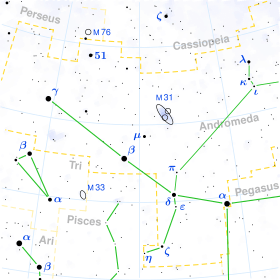HD 10307
HD 10307 (HR 483) is a spectroscopic binary star in the constellation Andromeda. The primary is similar to the Sun in mass, temperature and metal content. situated about 42 light-years from Earth Its companion, HR 483 B, is a little-studied red dwarf.
| Observation data Epoch J2000.0 Equinox J2000.0 | |
|---|---|
| Constellation | Andromeda |
| Right ascension | 01h 41m 47.1431s[1] |
| Declination | +42° 36′ 48.4435″[1] |
| Apparent magnitude (V) | 4.95 / 11[2] |
| Characteristics | |
| Spectral type | G1.5 V + M V[3] |
| U−B color index | 0.11[4] |
| B−V color index | 0.62[4] |
| Astrometry | |
| Radial velocity (Rv) | 3.1±0.12[5] km/s |
| Proper motion (μ) | RA: 813.337±0.380[1] mas/yr Dec.: −171.027±0.464[1] mas/yr |
| Parallax (π) | 76.5204 ± 0.2142[1] mas |
| Distance | 42.6 ± 0.1 ly (13.07 ± 0.04 pc) |
| Absolute magnitude (MV) | 4.43[6] |
| Absolute bolometric magnitude (Mbol) | 4.32 ± 0.06[7] |
| Orbit | |
| Period (P) | 19.7424[8] yr |
| Semi-major axis (a) | 0.631[2]″ |
| Eccentricity (e) | 0.437±0.024[8] |
| Inclination (i) | 98.8[2]° |
| Longitude of the node (Ω) | 205.0[2]° |
| Periastron epoch (T) | HJD 2443259±75[8] |
| Argument of periastron (ω) (secondary) | 203.71±4.51[8]° |
| Semi-amplitude (K1) (primary) | 2.966±0.110[8] km/s |
| Details | |
| HD 10307 A | |
| Mass | 1.02[7] M☉ |
| Radius | 1.14 ± 0.04[7] R☉ |
| Luminosity | 1.44[7] L☉ |
| Surface gravity (log g) | 4.30 ± 0.10[7] cgs |
| Temperature | 5878 ± 60[7] K |
| Metallicity [Fe/H] | +0.00 ± 0.06[7] dex |
| Rotational velocity (v sin i) | 1.5 ± 1.0[7] km/s |
| Age | 7.0 × 109[9] years |
| HD 10307 B | |
| Mass | 0.38 ± 0.07[3] M☉ |
| Luminosity | 0.0013[10] L☉ |
| Other designations | |
| Database references | |
| SIMBAD | HD 10307 |
| ARICNS | HD 10307 A |
| HD 10307 B | |
HD 10307 was identified in September 2003 by astrobiologist Margaret Turnbull from the University of Arizona in Tucson as one of the most promising nearby candidates for hosting life based on her analysis of the HabCat list of stars.[11]
System

HR 483 is a binary located 42.6 ly away, in Andromeda. The two stars orbit one another elliptically (e=0.44),[8] approaching as close as 4.2 AU and receding to 10.5 AU, with a period of just under twenty years. Due to the high margins of error on the mass estimates for the two stars, these orbital parameters are approximate.[2]
HD 10307 A, the larger component, is a G-type main-sequence star similar to the Sun, only slightly brighter, hotter, larger, and older than the Sun—though with a slightly smaller mass. It has a low level of activity and is a candidate Maunder minimum analog.[12] HR 483 B, the smaller component, appears to be a red dwarf, with as little as thirty-eight percent the mass of the sun.[3] A debris disk has been detected in this system.[13]
The presence of a moderately close companion could disrupt the orbit of a hypothetical planet in HD 10307's habitable zone. However, the uncertainty of the orbital parameters makes it equally uncertain exactly where stable orbits would be in this system.[10]
METI message to HD 10307
There was a METI message sent to HD 10307. It was transmitted from Eurasia's largest radar, 70-meter Eupatoria Planetary Radar. The message was named Cosmic Call 2, it was sent on July 6, 2003, and it will arrive at HD 10307 in September 2044.[14]
References
- Brown, A. G. A.; et al. (Gaia collaboration) (August 2018). "Gaia Data Release 2: Summary of the contents and survey properties". Astronomy & Astrophysics. 616. A1. arXiv:1804.09365. Bibcode:2018A&A...616A...1G. doi:10.1051/0004-6361/201833051. Gaia DR2 record for this source at VizieR.
- "Sixth Catalog of Orbits of Visual Binary Stars". United States Naval Observatory.
- Belikov, A. N. (1995). "Stellar Mass Catalogue (SMAC). Preliminary version". Bulletin d'Information du Centre de Données Stellaires. 47: 9. Bibcode:1995BICDS..47....9B.
- Database entry, Catalogue of Stellar Photometry in Johnson's 11-color system (2002 Ed.), J. R. Ducati, CDS ID II/237 Accessed on line 2018-12-05.
- Pourbaix, D.; et al. (September 2004), "SB9: The ninth catalogue of spectroscopic binary orbits", Astronomy and Astrophysics, 424 (2): 727–732, arXiv:astro-ph/0406573, Bibcode:2004A&A...424..727P, doi:10.1051/0004-6361:20041213.
- Holmberg, J.; et al. (July 2009), "The Geneva-Copenhagen survey of the solar neighbourhood. III. Improved distances, ages, and kinematics", Astronomy and Astrophysics, 501 (3): 941–947, arXiv:0811.3982, Bibcode:2009A&A...501..941H, doi:10.1051/0004-6361/200811191.
- Fuhrmann, Klaus (2011). "Nearby stars of the Galactic disc and halo - V". Monthly Notices of the Royal Astronomical Society. 414 (4): 2893–2922. Bibcode:2011MNRAS.414.2893F. doi:10.1111/j.1365-2966.2011.18476.x.
- Halbwachs, J. -L; Mayor, M.; Udry, S.; Fekel, F. C.; Hartkopf, W. I.; Levato, H.; Morrell, N. I.; Torres, G.; Udry, S. (2018). "Multiplicity among solar-type stars. IV. The CORAVEL radial velocities and the spectroscopic orbits of nearby K dwarfs". Astronomy and Astrophysics. 619: A81. arXiv:1808.04605. Bibcode:2018A&A...619A..81H. doi:10.1051/0004-6361/201833377.
- Mamajek, Eric E.; Hillenbrand, Lynne A. (November 2008). "Improved Age Estimation for Solar-Type Dwarfs Using Activity-Rotation Diagnostics". The Astrophysical Journal. 687 (2): 1264–1293. arXiv:0807.1686. Bibcode:2008ApJ...687.1264M. doi:10.1086/591785.
- "SolStation: HR 483 / HD 10307 AB".
- P. M. Bagnall. The Star Atlas Companion: What you need to know about the Constellations.
- Lubin, Dan; Tytler, David; Kirkman, David (March 2012), "Frequency of Maunder Minimum Events in Solar-type Stars Inferred from Activity and Metallicity Observations", The Astrophysical Journal Letters, 747 (2): L32, Bibcode:2012ApJ...747L..32L, doi:10.1088/2041-8205/747/2/L32.
- Rodriguez, David R.; Duchêne, Gaspard; Tom, Henry; Kennedy, Grant M.; Matthews, Brenda; Greaves, Jane; Butner, Harold (2015). "Stellar multiplicity and debris discs: An unbiased sample". Monthly Notices of the Royal Astronomical Society. 449 (3): 3160. Bibcode:2015MNRAS.449.3160R. doi:10.1093/mnras/stv483.
- (in Russian) http://www.cplire.ru/rus/ra&sr/VAK-2004.html
